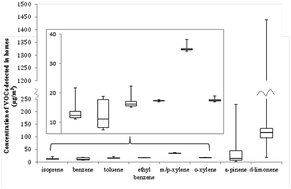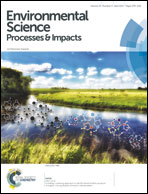Unexpectedly high concentrations of monoterpenes in a study of UK homes†
Abstract
The abundance of volatile organic compounds (VOCs) found in homes depends on many factors such as emissions, ventilation and the oxidative environment and these are evolving over time, reflecting changes in chemical use, behaviour and building design/materials. The concentrations of VOCs in 25 UK homes of varying ages, design and occupancy were quantified using continuous indoor air sampling over five days. Air was collected through low flow (1 mL min−1) constant flow restrictors into evacuated 6 L internally silica-treated canisters until the canisters reached atmospheric pressure. This was followed by thermal desorption-gas chromatography and high mass accuracy time-of-flight mass spectrometry (TD-GC-TOF/MS). A fully quantitative analysis was performed on the eight most abundant hydrocarbon-based VOCs found. Despite differences in building characteristics and occupant numbers 94% of the homes had D-limonene or α-pinene as the most abundant VOCs. The variability seen across the 25 homes in concentrations of monoterpenes indoors was considerably greater than that of species such as isoprene, benzene, toluene and xylenes. The variance in VOCs indoors appeared to be strongly influenced by occupant activities such as cleaning with 5-day average concentrations of D-limonene ranging from 18 μg m−3 to over 1400 μg m−3, a peak domestic value that is possibly the highest yet reported in the literature.



 Please wait while we load your content...
Please wait while we load your content...